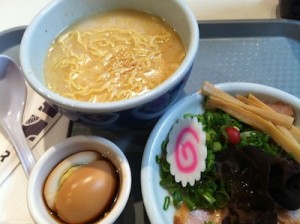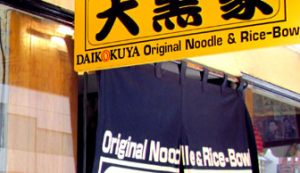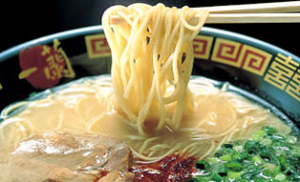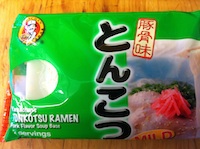 It took me two years to figure out what the deal was with the toroniku pork at Santouka Ramen. I’d ask the nice Japanese woman behind the counter what kind of meat would accompany my ramen and she would say it was slices of pork neck. Neck? “Jaw,” another one said. And another: “Pig face.” After much online sleuthing, I learned that it’s pork cheek. So, when I order my favorite Santouka ramen—the Number 7 Toroniku with Shio (salt) broth—it comes with a little pinwheel of pork cheek slices that are marinated and cooked until supernaturally tender and delicious. Also, menma (bamboo shoots), wood ear mushrooms, green onions, kamaboko (fish cake) and a deeply sour salted umeboshi plum.
It took me two years to figure out what the deal was with the toroniku pork at Santouka Ramen. I’d ask the nice Japanese woman behind the counter what kind of meat would accompany my ramen and she would say it was slices of pork neck. Neck? “Jaw,” another one said. And another: “Pig face.” After much online sleuthing, I learned that it’s pork cheek. So, when I order my favorite Santouka ramen—the Number 7 Toroniku with Shio (salt) broth—it comes with a little pinwheel of pork cheek slices that are marinated and cooked until supernaturally tender and delicious. Also, menma (bamboo shoots), wood ear mushrooms, green onions, kamaboko (fish cake) and a deeply sour salted umeboshi plum.
Artisanal ramen is inspiring a weird brand of devotion from New York hipsters, self-confessed food geeks and this middle-aged writer. What’s going on?
To say that I never eat pork cheek, salted plums, Hello-Kitty-colored fish cakes or wood ear mushrooms in my regularly scheduled life is an understatement. And the ramen? Like the composée bowls popping up at earnest eateries in Southern California, New York and around the country, Santouka’s is sublime, like nothing I’ve tasted before it. The noodles are divinely fresh and firm. The broth: Cloudy with collagen and essentially porky with overtones of the Hokkaido seafood shipped in to add to the pot, it tastes of aromatics, garlic, the sea. This is strange, exotic cooking.
And it tastes exactly like home.
The Way It Should Always Be
I say this without irony, even though my mother never cooked anything resembling this ramen. She was not inclined to the butchering of pork bones, the long slow simmering of soup, or the loving preparation of toppings. I grew up eating Sapporo Ichiban in the red (original flavor) package. I ate it willingly and often—not just the prepared soup, but also the raw noodles (admit it, you tried them too) and the salty granules left in the flavor packet after the soup was done.
The broth: Cloudy with collagen and essentially porky with overtones of the Hokkaido seafood shipped in to add to the pot, it tastes of aromatics, garlic, the sea. This is strange, exotic cooking.
But this has nothing to do with my reasons for driving 32 miles to Monterey Park to meet my boyfriend Charlie at a ramenya called Daikokuya. We’ve deliberately shunned Daikokuya’s hip Little Tokyo outlet in favor of less fashionable, less crowded, and distinctly humble surroundings. We sit across from each other at a teeny tiny table and await the ramen. Just ten feet away the cooks are tending giant stainless steel vats of simmering broth.
It arrives. We have a moment of silence while we take in the heady scent of the broth. It ‘s completely opaque without being thick, and drinking it is like wrapping yourself in a pork-infused blanket.  We eat without talking until one of us observes that this is soul food, like you are literally feeding your soul.
We eat without talking until one of us observes that this is soul food, like you are literally feeding your soul.
I’ve recently read that the collagen in ramen broth is good for you—that it repairs your muscles and skin. I want to believe this is true even though I probably know better. Unless I’m planning to apply the broth directly to my face, I’m pretty sure there’s not going to be a lasting dermatological benefit. On the other hand, I don’t care. After drinking down the entire bowl of broth, I feel glowing. And if that glow comes from a thin sheen of vaporized pork fat adhering to my skin, so be it.
The Ramen Crawl
This is how I find myself on a quietly compulsive, slightly depraved quest. My new north star is a guy who calls himself Rameniac. Check out his site and learn everything—seriously, everything—about ramen. Rickmond Wong knows ramen, having eaten his way around Japan, bowl by bowl. He’s been to the New York hot spots (Ippudo, Momofuku Noodle Bar) and he’s been to every ramen joint within a 10 mile radius of my Redondo Beach home.
The Rameniac identifies 22 discrete styles of Japanese ramen. Within these genres are endless individual variations, wrought by individual ramen makers who toil in little shops all over Japan and specialize to the Nth degree. Here in the States, ramenya are a mixed bag—some are chains imported from Japan, some offer homebrews with their own quirky spin. Wong brings them all to life in restaurant reviews so precise and immensely readable, you can’t help devouring the whole site. Like most Americans, Wong grew up without the benefit of really great ramen. “But when I lived in Japan teaching English, I developed a real interest in ramen and ramenya,” Wong says. “When I came back to the States, I wanted to spread the word.”

That was in 2006, before the U.S. knew about great ramen – or, for that matter, food blogging. But Wong’s subject matter, medium of choice, and audience made a delicious fit. In other words, ramen culture was tailor-made for the age of anime and food chronicling. “Kids are growing up with an exposure to Japanese culture through anime,” he says. “Ramen hits a similar note. It’s cool. It’s not stuffy Japanese culture or [something rarefied like] sushi.” Also, the same chromosome that makes kids want to collect Pokemon might also compel them to try, exhaustively, style after style of authentic ramen.
Cracking the Broth Code
For New York chef and food historian Marc Matsumoto, ramen obsession took a different spin. While other college students were content with Top Ramen, he began reverse engineering the ramen he enjoyed during his travels to Japan. After a mere 12 years of trial and error, he posted his recipe for tonkotsu broth on his cooking site, No Recipes, in 2009. He’s revised the recipe four times since.
“When I started trying to make ramen, I was already doing a lot of cooking,” he says. “But these techniques, these ingredients were so foreign to my experience that it was a huge challenge.”
Not as good, but we can’t stop eating it
Problem: Writing about ramen compels you to eat, but sneaking out every 45 minutes for an artisanal bowl is slowing you down. What to do?
Somewhat satisfactory solution: This packaged ramen – Yamachan’s Tonkotsu Ramen – is nothing like what you’d get at a real ramenya, but it is strangely addicting. Fresh eggy noodles and a mild, porky soup base are completely edible. The soup packet even contains a delightful marbling of lard (OK, yeah, we called lard “delightful”). No toppings, so you have to add your own egg, leftover meat or vegetables. Or – who are you kidding? – just eat it straight. Mmmmmm good!
Yet, there’s something about ramen that makes otherwise sensible people like Matsumoto want to persevere. He, too, has made the rounds. He fondly recalls a visit to Ramen Stadium in Fukuoka, Japan, where the best ramenya from around the country are represented at a single location. “I ate three bowls in a single visit and they were the three best bowls I’ve ever had,” he says. Creating his own ramen is one way Matsumoto honors that experience. He also posts recipes for ramen noodles (made with a mysterious ingredient called kansui, which he tells you how to source) and his version of Santouka’s toroniku pork.
Slurping Globally
We both squeal a little when we talk about the toroniku. We’ve never met and we’re on opposite coasts, but suddenly Matsumoto and I are rhapsodizing about pork cheeks. “They’re so tender and they have such a high fat content, they’re like foie gras,” he says. “They literally melt in your mouth.”
There’s silence, and for a moment we aren’t thinking about the interview or each other, only about that ramen—the faintly sweet, brilliantly lardy broth; those delicious noodles; that pork.
We’ve never met and we’re on opposite coasts, but suddenly Matsumoto and I are rhapsodizing about pork cheeks.
And in a weird, inexplicable way, that’s the mystique of ramen—and maybe every kind of food that binds people together across cultures, experience and geography. It invites description, but doesn’t require it. It lures you in with its endless variation, its distinct personalities, but it’s familiar too. You don’t have to be a world traveler, cultivated palate, or Japanese to “get” ramen. Pick up your bowl and start slurping. You’re home.

Reading this has put me in the mood for ramen! Unfortunately, it’s only 8:40 am here. Santouka is my fave! (Daikokuya … not so much.) When my mother in law visits from Japan later this month, I’m going to get her to teach me to make chashu. Thanks for the great post!
Extremely well-written homage to all things Ramen. Who knew? Not I, for one. I love your line:” And in a weird, inexplicable way, that’s the mystique of ramen—and maybe every kind of food that binds people together across cultures, experience and geography. It invites description, but doesn’t require it…”
I have been hankering to get to Japan after interviewing a developer there (twice). I even fantasized about Tokyo on this year’s vision collage. Here’s hoping. I ate fusion food with a half-Japanese man in London in 2005. Maybe I’ll do pork cheeks and Ramen in Japan with an Englishman.